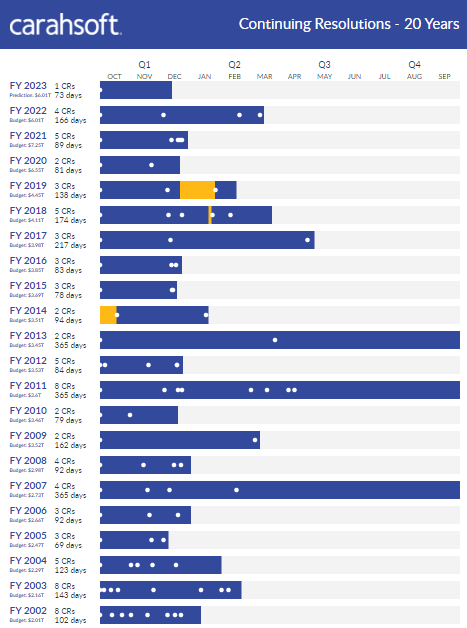What is a Continuing Resolution (CR), and How Does it Impact Your Sales Strategy for the Upcoming Year?
As the Federal Governments fiscal year rapidly comes to a close (Sept. 30th), many companies are in the process of developing both their sales strategies and revenue forecasting models to support their government business for FY 2023. One of the items companies should account for when developing their strategies and models (especially around forecasting) is the Governments Continuing Resolution process or CR as it is more commonly referred to in Government circles.
A CR is a type of Appropriations Bill utilized by the Federal Government in times where Congress and the President have not signed the traditional Appropriations Bills into law on time (Oct. 1st). The CR is designed to temporarily fund Government operations until the traditional Appropriation Bills are passed. If CR legislation is not passed, the Federal Government would be forced to shut down (The Committee for a Responsible Federal Budget provides a great overview and set of resources on this topic: Q&A: Everything You Should Know About Government Shutdowns | Committee for a Responsible Federal Budget (crfb.org)).
According to research provided by our partners at Carahsoft, the Government's use of a CR to temporarily fund its operations is more the norm than the exception. (The last time the Government passed all Appropriations Bills on time was 1997.) The real question organizations should be asking is not "will there be a CR?" but rather "how long will the CR last?".
The main affect a CR has on organizations is that a CR funds Government at the previous year’s appropriations rate. This funding level has major implications on making purchases for which there are no funds from the previous year. Essentially, this means, NO NEW STARTS. If your software contract is a new purchase for the agency, chances are Government will NOT be able to make the purchase until the traditional Appropriation Bills are passed. The NO NEW STARTS policy can cause problems not only for companies selling to the Government but also for Government agencies and programs themselves. The DoD for instance frequently criticizes this constraint because it can, for example, delay the development of new weapons programs, stall new contracts, and prevent new hires (https://www.concordcoalition.org/node/14848).
For items such as software renewals for products that were included in the last’s year appropriation bills, as long as the renewal amount is in line with the previous year’s funding level the Government should be able to award your contract.
The current information coming from Congress indicates that negotiations on a CR have already started. With that we anticipate a CR will be passed on or about October 1st and will run until around mid-December. At Marion Square we are advising our clients to:
Focus, push hard, and close out as much revenue during the final month of the Government year (Sept), especially for any contracts supporting new starts.
Do NOT forecast net new revenue from Government during a CR.
Continue sales and marketing efforts during a CR because once the Appropriation Bills are passed the Government will be in a race against time to spend their funds and launch their new initiatives.
While Congress has not passed a CR for FY 2023, if what we are hearing is true, and the past is any predictor of the future, organizations should be planning to kick off the Government FY 2023 under a CR.


